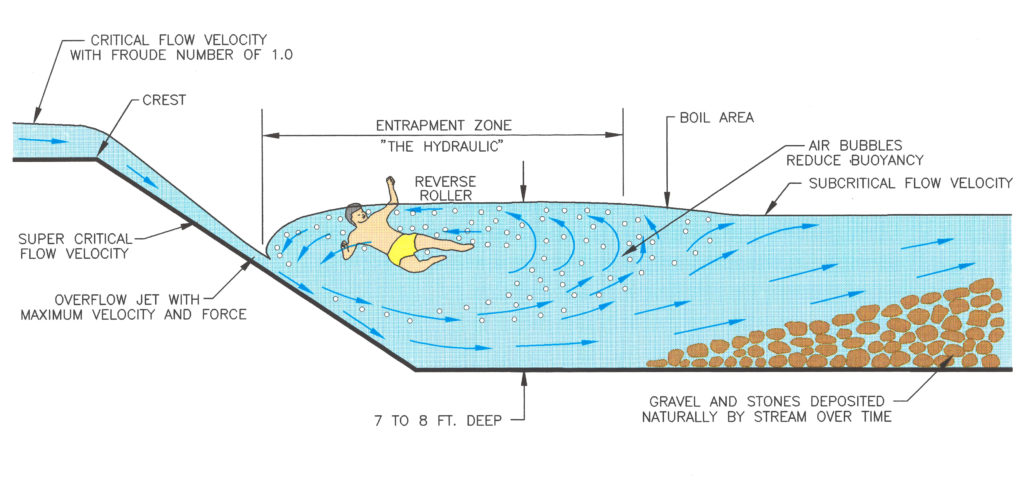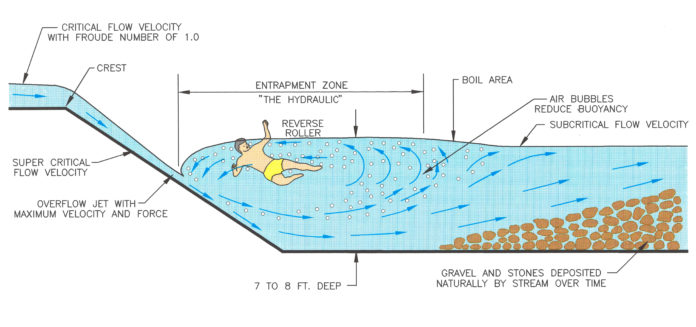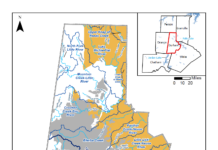By Kenneth Wright, P.E.
An innocuous looking structure to most people, low-head dams have claimed the lives of more than 1,400 recreationists, rescue personnel, dam owners and maintenance personnel.1
More commonly known as weirs or diversion ditches, low-head dams are defined by the Federal Register as underwater structures typically 5- to 15-feet high that are designed and built to span a waterway such that water continuously flows over the crest from bank to bank.
Although originally used for milling and hydropower, today they are used for irrigation, municipal water supply, channel grade control, stormwater management and aesthetics. These “attractive nuisances” appeal to water recreationists engaged in activities such as rafting, tubing or fishing along rivers and urban drainage corridors.
At certain flow levels, many low-head dams develop a dangerous hydraulic “boil” at the toe that can trap people and watercraft. Watercraft often capsize in the churning water, and a person can be circulated through the water so quickly and in such a confusion of bubbles that they do not know which way is up. These dangers are hard to anticipate because the boils are not present under all flow conditions and often the pooled water above the dams appears placid. People going down the river in a watercraft do not see the churning water at the toe of the dam until they are in it. Without immediate and experienced help, even strong swimmers can become exhausted and drown.
The fastest path to low-head dam hazard mitigation is through public safety awareness. Many states have initiated efforts to identify the locations of low-head dams and educate the public through the placement of warning signs and buoys, as well as conducting publicity campaigns to educate the public about these hidden dangers.
There are non-governmental organizations working to remove or retrofit existing low-head dams through engineered structures to eliminate the dangerous reverse roller effect of the recirculating water by dissipating energy as the water spills over the dam. In Colorado, Urban Drainage Engineer Kenneth Wright, P.E., is conducting safety lectures to water rescue and fire department personnel as an outreach of the Association of State Dam Safety Officials. Recently, a collaborative effort between Wright Water Engineers; Ruth Wright, a water resources attorney and former Colorado state legislator; and professors Robert Houghtalen and Rollin Hotchkiss distributed an educational package to engineering faculties throughout the country to be used as lecture material with the goal of raising awareness among future engineers.
One of the greatest challenges that remains is locating and verifying the tens of thousands of low-head dams throughout the U.S. Recently, a group of professionals representing the civil engineering profession from academia, government and consulting formed the National Low Head Dam Inventory Task Force. The group is developing a web-based app and a Survey123 app to collect field data on these dams which will populate a database to serve as a living tool for government entities, non-governmental organizations, engineers and the public.
All of these efforts require support. For more information, or to get involved, please contact Beth Knudsen, Low-head Dam Liaison, at bknudsen@wrightwater.com.

About the Expert
Kenneth R. Wright, P.E., is founder and principal engineer of Wright Water Engineers, Inc., a civil engineering consulting firm in Denver. He has served as a dam safety expert in lawsuits on drownings at low-head dams in Colorado, Oregon, New Jersey and West Virginia. He currently serves on the Public Safety at Dams committee for the Association of State Dam Safety Officials (ASDSO) and received the Bruce Tschantz Public Safety at Dams award from ASDSO in 2019.
Reference
1) Israel, Benjamin. 2020. Personal Communication re: Association of State Dam Safety Officials Fatalities Database. July 22.












